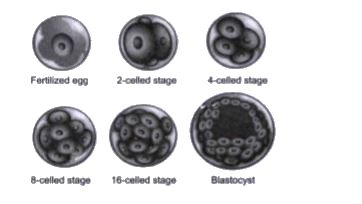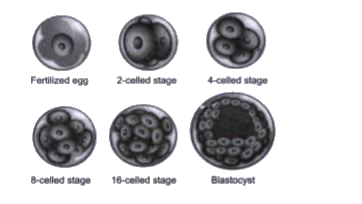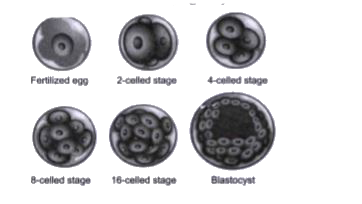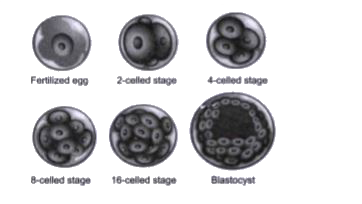Cleavage is the series of rapid mitotic divisions in zygote and forms blastula. The 2, 4, 8, 16 daughter cells are called blastomere. Embryo with 64 blastomere is known as blastocyst and has blastocoel cavity. Blastocyst gets implanted in uterine wall and leads to pregnancy.

The cells within the inner cell mass that possess the ability to give rise to the entire organism are called:
placental cells
stem cells
mother cells
zygote
The correct Answer is:B
The stem cells are a population of cells within the inner cell mass that possess the ability of giving rise to an entire organism.
Topper's Solved these Questions
Similar Questions
Cleavage is the series of rapid mitotic divisions in zygote and forms blastula. The 2, 4, 8, 16 daughter cells are called blastomere. Embryo with 64 blastomere is known as blastocyst and has blastocoel cavity. Blastocyst gets implanted in uterine wall and leads to pregnancy.

The solid mass of 8-16 cells formed from zygote after successive mitotic division is called:
View SolutionAssertion: The embryo with 8 to 16 blastomeres is called a morula.
Reason: The blasometeres in the morula are arranged into an outer layer called trophoblast and an inner group of cells attached to trophoblast called the inner cell mass.
View Solution
Knowledge Check
Cleavage is the series of rapid mitotic divisions in zygote and forms blastula. The 2, 4, 8, 16 daughter cells are called blastomere. Embryo with 64 blastomere is known as blastocyst and has blastocoel cavity. Blastocyst gets implanted in uterine wall and leads to pregnancy.

Site of implantation is:AEndometrium of uterusBCervixCUterine fundusDInfundibulum of oviductCleavage is the series of rapid mitotic divisions in zygote and forms blastula. The 2, 4, 8, 16 daughter cells are called blastomere. Embryo with 64 blastomere is known as blastocyst and has blastocoel cavity. Blastocyst gets implanted in uterine wall and leads to pregnancy.

Solid mass of cells with 16 blastomere is called:AMorulaBBlastulaCGastrulaDZygoteCleavage is the series of rapid mitotic divisions in zygote and forms blastula. The 2, 4, 8, 16 daughter cells are called blastomere. Embryo with 64 blastomere is known as blastocyst and has blastocoel cavity. Blastocyst gets implanted in uterine wall and leads to pregnancy.

Correct sequence of various structures formed during embryonic development:AMorula → Embryo → Gastrula → BlastulaBZygote → Embryo → Morula → BlastulaCBlastula → Morula → Gastrula → ZygoteDZygote → Morula → Blastula → Gastrula
Read the passage and answer the questions:
Implantation is the embedding of the blastocyst into the endometrium of the uterus. Blastocyst is a ball of cells with a large, fluid-filled cavity called the blastocoel. The blastomeres in the blastocyst are arranged into an outer layer called trophoblast and inner cell mass. With the formation of blastocoel, morula is converted to blastula which is called blastocyst in mammals.
The ectoderm cells will form the........
View SolutionRead the passage and answer the questions:
Implantation is the embedding of the blastocyst into the endometrium of the uterus. Blastocyst is a ball of cells with a large, fluid-filled cavity called the blastocoel. The blastomeres in the blastocyst are arranged into an outer layer called trophoblast and inner cell mass. With the formation of blastocoel, morula is converted to blastula which is called blastocyst in mammals.
Assertion (A): Blastocyst undergoes gastrulation to form three germinal layers.
Reason (R): This involves cell movements (morphogenetic movement) that help to attain new shape and morphology of embryo.
View SolutionRead the passage and answer the questions:
Implantation is the embedding of the blastocyst into the endometrium of the uterus. Blastocyst is a ball of cells with a large, fluid-filled cavity called the blastocoel. The blastomeres in the blastocyst are arranged into an outer layer called trophoblast and inner cell mass. With the formation of blastocoel, morula is converted to blastula which is called blastocyst in mammals.
State of embryo development, in which implantation occurs in human female is:
View SolutionRead the passage and answer the questions:
Implantation is the embedding of the blastocyst into the endometrium of the uterus. Blastocyst is a ball of cells with a large, fluid-filled cavity called the blastocoel. The blastomeres in the blastocyst are arranged into an outer layer called trophoblast and inner cell mass. With the formation of blastocoel, morula is converted to blastula which is called blastocyst in mammals.
The process that transforms the embryo into a three-layered stage is called.....
View SolutionRead the passage and answer the questions:
Implantation is the embedding of the blastocyst into the endometrium of the uterus. Blastocyst is a ball of cells with a large, fluid-filled cavity called the blastocoel. The blastomeres in the blastocyst are arranged into an outer layer called trophoblast and inner cell mass. With the formation of blastocoel, morula is converted to blastula which is called blastocyst in mammals.
Which organ is formed during gastrulation ?
View Solution
